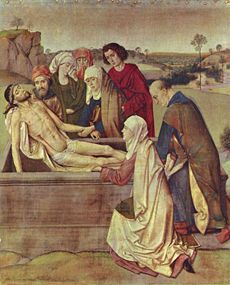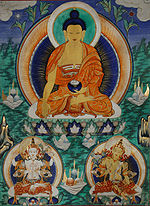.gif)
Distemper (paint)
Encyclopedia
Distemper is a term with a variety of meanings for paint
s used in decorating and as a historical medium for painting pictures. The binding element may be some form of glue
or oil; these are known in decorating respectively as soft distemper and oil bound distemper.
 Distemper is an early form of whitewash
Distemper is an early form of whitewash
, also used as a medium for artistic painting
, usually made from powdered chalk
or lime
and size
(a gelatinous substance). Alternatives to chalk include the toxic substance, white lead
.
Distempered surfaces can be easily marked and discoloured, and cannot be washed down, so distemper is best suited to temporary and interior decoration. The technique of painting on distempered surfaces blends watercolors with whiting and glue. "The colours are mixed with whitening, or finely-ground chalk, and tempered with size. The whitening makes them opaque and gives them 'body,' but is also the cause of their drying light...a source of considerable embarrassment to the inexperienced eye is that the colours when wet present such a different appearance from what they do when dry."
 Many Medieval and Renaissance painters used distemper painting rather than oil paint for some of their works. The earliest paintings on canvas
Many Medieval and Renaissance painters used distemper painting rather than oil paint for some of their works. The earliest paintings on canvas
were mostly in distemper, which was (and is) also widely used in Asia, especially in Tibet
an thankas. Distemper paintings suffer more than oil paintings as they age, and relatively few have survived. It was the commonest medium for painting banners and decorations for temporary celebrations, both of which attracted artists of the highest quality, especially when they were official court artists. In distemper painting, "the carbonate of lime, or whitening employed as a basis, is less active than the pure lime of fresco
...to give adhesion to the tints and colours in distemper painting, and to make them keep their place, they are variously mixed with the size of glue (prepared commonly by dissolving about four ounces of glue in a gallon of water). Too much of the glue disposes the painting to crack and peel from the ground; while, with too little, it is friable and deficient in strength."
The National Gallery, London
distinguishes between the techniques of glue
, glue size
, or glue-tempera
, which is how they describe their three Andrea Mantegna
s in the medium, and distemper, which is how they describe their Dirk Bouts
and two Edouard Vuillard
s (see below). Other sources would describe the Mantegnas as also being in distemper.
In modern practice, distemper painting is often employed for scenery painting in theatrical productions and other short-term applications and also cheaper than oil paint. Contemporary artist John Connell
, was known for using distemper in paintings sometimes as large as ten feet.
Paint
Paint is any liquid, liquefiable, or mastic composition which after application to a substrate in a thin layer is converted to an opaque solid film. One may also consider the digital mimicry thereof...
s used in decorating and as a historical medium for painting pictures. The binding element may be some form of glue
Glue
This is a list of various types of glue. Historically, the term "glue" only referred to protein colloids prepared from animal flesh. The meaning has been extended to refer to any fluid adhesive....
or oil; these are known in decorating respectively as soft distemper and oil bound distemper.
Soft distemper

Whitewash
Whitewash, or calcimine, kalsomine, calsomine, or lime paint is a very low-cost type of paint made from slaked lime and chalk . Various other additives are also used...
, also used as a medium for artistic painting
Painting
Painting is the practice of applying paint, pigment, color or other medium to a surface . The application of the medium is commonly applied to the base with a brush but other objects can be used. In art, the term painting describes both the act and the result of the action. However, painting is...
, usually made from powdered chalk
Calcium carbonate
Calcium carbonate is a chemical compound with the formula CaCO3. It is a common substance found in rocks in all parts of the world, and is the main component of shells of marine organisms, snails, coal balls, pearls, and eggshells. Calcium carbonate is the active ingredient in agricultural lime,...
or lime
Calcium hydroxide
Calcium hydroxide, traditionally called slaked lime, is an inorganic compound with the chemical formula Ca2. It is a colourless crystal or white powder and is obtained when calcium oxide is mixed, or "slaked" with water. It has many names including hydrated lime, builders lime, slack lime, cal, or...
and size
Sizing
Sizing or size is any one of numerous specific substances that is applied to or incorporated in other material, especially papers and textiles, to act as a protecting filler or glaze....
(a gelatinous substance). Alternatives to chalk include the toxic substance, white lead
Lead carbonate
Lead carbonate is the chemical compound PbCO3. It is prepared industrially from lead acetate and carbon dioxide.It occurs naturally as the mineral cerussite.-Basic lead carbonates:...
.
Distempered surfaces can be easily marked and discoloured, and cannot be washed down, so distemper is best suited to temporary and interior decoration. The technique of painting on distempered surfaces blends watercolors with whiting and glue. "The colours are mixed with whitening, or finely-ground chalk, and tempered with size. The whitening makes them opaque and gives them 'body,' but is also the cause of their drying light...a source of considerable embarrassment to the inexperienced eye is that the colours when wet present such a different appearance from what they do when dry."

Canvas
Canvas is an extremely heavy-duty plain-woven fabric used for making sails, tents, marquees, backpacks, and other items for which sturdiness is required. It is also popularly used by artists as a painting surface, typically stretched across a wooden frame...
were mostly in distemper, which was (and is) also widely used in Asia, especially in Tibet
Tibet
Tibet is a plateau region in Asia, north-east of the Himalayas. It is the traditional homeland of the Tibetan people as well as some other ethnic groups such as Monpas, Qiang, and Lhobas, and is now also inhabited by considerable numbers of Han and Hui people...
an thankas. Distemper paintings suffer more than oil paintings as they age, and relatively few have survived. It was the commonest medium for painting banners and decorations for temporary celebrations, both of which attracted artists of the highest quality, especially when they were official court artists. In distemper painting, "the carbonate of lime, or whitening employed as a basis, is less active than the pure lime of fresco
Fresco
Fresco is any of several related mural painting types, executed on plaster on walls or ceilings. The word fresco comes from the Greek word affresca which derives from the Latin word for "fresh". Frescoes first developed in the ancient world and continued to be popular through the Renaissance...
...to give adhesion to the tints and colours in distemper painting, and to make them keep their place, they are variously mixed with the size of glue (prepared commonly by dissolving about four ounces of glue in a gallon of water). Too much of the glue disposes the painting to crack and peel from the ground; while, with too little, it is friable and deficient in strength."
The National Gallery, London
National Gallery, London
The National Gallery is an art museum on Trafalgar Square, London, United Kingdom. Founded in 1824, it houses a collection of over 2,300 paintings dating from the mid-13th century to 1900. The gallery is an exempt charity, and a non-departmental public body of the Department for Culture, Media...
distinguishes between the techniques of glue
Glue
This is a list of various types of glue. Historically, the term "glue" only referred to protein colloids prepared from animal flesh. The meaning has been extended to refer to any fluid adhesive....
, glue size
Sizing
Sizing or size is any one of numerous specific substances that is applied to or incorporated in other material, especially papers and textiles, to act as a protecting filler or glaze....
, or glue-tempera
Tempera
Tempera, also known as egg tempera, is a permanent fast-drying painting medium consisting of colored pigment mixed with a water-soluble binder medium . Tempera also refers to the paintings done in this medium. Tempera paintings are very long lasting, and examples from the 1st centuries AD still exist...
, which is how they describe their three Andrea Mantegna
Andrea Mantegna
Andrea Mantegna was an Italian painter, a student of Roman archeology, and son in law of Jacopo Bellini. Like other artists of the time, Mantegna experimented with perspective, e.g., by lowering the horizon in order to create a sense of greater monumentality...
s in the medium, and distemper, which is how they describe their Dirk Bouts
Dirk Bouts
Dieric Bouts was an Early Netherlandish painter. According to Karel van Mander in his Het Schilderboeck of 1604, Bouts was born in Haarlem and was mainly active in Leuven , where he was city painter from 1468...
and two Edouard Vuillard
Édouard Vuillard
Jean-Édouard Vuillard was a French painter and printmaker associated with the Nabis.-Early years and education:...
s (see below). Other sources would describe the Mantegnas as also being in distemper.
In modern practice, distemper painting is often employed for scenery painting in theatrical productions and other short-term applications and also cheaper than oil paint. Contemporary artist John Connell
John Connell
John Connell was a contemporary American artist. His works included sculpture, painting, drawing, and writing....
, was known for using distemper in paintings sometimes as large as ten feet.
Examples of paintings in distemper
- Fayum mummy portraitsFayum mummy portraitsMummy portraits or Fayum mummy portraits is the modern term given to a type of naturalistic painted portraits on wooden boards attached to mummies from the Coptic period. They belong to the tradition of panel painting, one of the most highly regarded forms of art in the Classical world...
, from Late Antique Egypt (some in encausticEncausticEncaustic may refer to:*Encaustic painting*Encaustic tile...
) - Dirk BoutsDirk BoutsDieric Bouts was an Early Netherlandish painter. According to Karel van Mander in his Het Schilderboeck of 1604, Bouts was born in Haarlem and was mainly active in Leuven , where he was city painter from 1468...
EntombmentThe Entombment (Bouts)The Entombment is a glue-size painting on linen attributed to the Early Netherlandish painter Dirk Bouts. It shows a scene from the biblical entombment of Christ, probably completed between 1440 and 1455 as a wing panel for a large hinged polyptych altarpiece...
, 1450s. National GalleryNational galleryThe National Gallery is an art gallery on Trafalgar Square, London, United Kingdom.National Gallery may also refer to:*Armenia: National Gallery of Armenia, Yerevan*Australia:**National Gallery of Australia, Canberra...
, London - Many paintings by Mantegna some examples. one from London
- The Raphael CartoonsRaphael CartoonsThe Raphael Cartoons are seven large cartoons for tapestries, now in the Victoria and Albert Museum, London, painted by the High Renaissance painter Raphael in 1515-16 and showing scenes from the Gospels and Acts of the Apostles...
, London - Edouard VuillardÉdouard VuillardJean-Édouard Vuillard was a French painter and printmaker associated with the Nabis.-Early years and education:...
Lunch at Vasouy, 1901. Tate Modern - Mark TobeyMark TobeyMark George Tobey was an American abstract expressionist painter, born in Centerville, Wisconsin. Widely recognized throughout the United States and Europe, Tobey is the most noted among the "mystical painters of the Northwest." Senior in age and experience, Tobey had a strong influence on the...
's White Journey, modern

